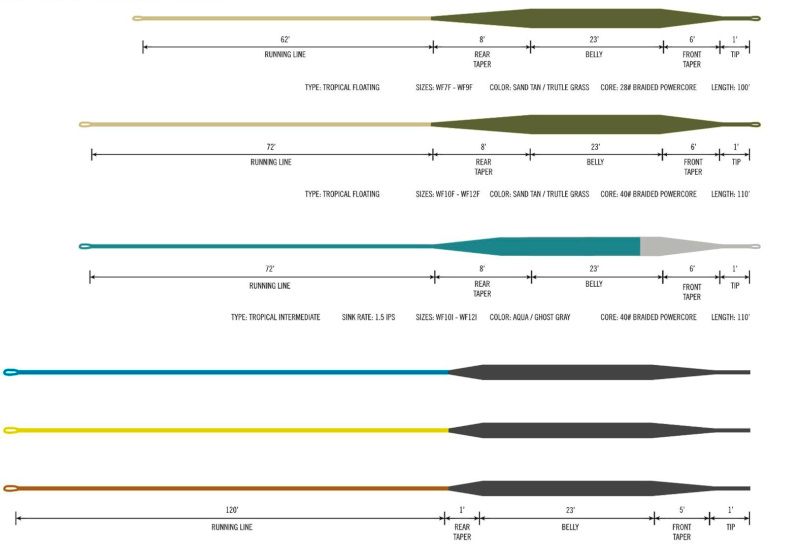
Fly Line Profiles. Photo: Hatch Outdoors.
Choosing the best fly line for your angling pursuits is the most important consideration of any fly rod setup. Contrary to popular belief, the fly line is the most ‘technically driven’ piece of equipment. Yes, more so than your high modulus graphite or sealed carbon fiber disc drags. There are a wide range of fly lines available today to target nearly every fishing scenario, but for many anglers out there, choosing one can be a bit overwhelming.
Most fly line companies provide fly line profiles, not to be confused with tapers (i.e. weight forward, double taper, etc.), for each fly line available. Line profiles are nothing more than a schematic of the line, highlighting the lengths of different sections of varying diameters, densities, textures and so on. They can be a great tool when selecting a fly line, but the role of each section of line is not often understood. Therefore, we thought we’d provide a rundown of the most common components found in fly line profiles and how they affect the performance of a line.
In a typical ‘weight forward’ fly line profile, you can expect to see some, or all of the following components..
- 30 ft. Weight: Just what it says, the 30 ft. weight is the weight of the first 30 feet of line measured in ‘grains.’ It’s what dictates the line’s appropriate line weight (i.e. 5 wt., 6wt., and so on). Why 30 feet? At 30 feet, both weight forward and double taper lines of the same ‘line weight’ should weigh the same, allowing for some consistency when matching lines to rods from varying manufacturers. However, there is an accepted degree of error in line weights, and some lines can vary from 1/2 to even 3/4 of a line size within the same ‘weight.’ Therefore, knowing the 30 ft. weight can be helpful in matching a line to your specific needs.
- Tip: The tip of the fly line is nothing more than a short level section to which the leader is attached. In the past, the tip was used to extend the life of the line by providing a section that can be trimmed after attaching a leader, without cutting into the taper of the fly line. With the popularity of welded loops however, the tip of the fly line is not as important today as it was before, and thus doesn’t need to be as long.
- Front Taper: The tapered section connecting the body to the tip of the line, the front taper determines how energy is dissipated from the line to the leader. A long gradual front taper allows for more delicate and accurate casts, while a short aggressive front taper lends itself to better turnover when casting heavy flies or casting into the wind, although is less accurate. Choose accordingly.
- Belly (Body): The belly, or body, of the line is the portion of the line with the widest diameter. It is where the majority of the energy is carried throughout the cast. The longer the belly of the line, the greater distance potential. The shorter the belly, the easier it is to load the rod quickly for shorter casts. Choose your belly length based on the distance you fish to most often.
- Rear (Back) Taper: The tapered section connecting the belly of the line to the running line, the rear taper is an underrated portion of the fly line. A long rear taper allows for greater control of the fly line over longer distances by creating a smooth transfer of energy. A shorter rear taper creates a quicker transition to the thin running line, allowing for greater distances when shooting line. Both have their advantages depending for the type of fishing at hand!
- Head: The head of the fly line is the section comprised of the front taper, belly, and rear taper. The length of the head determines the amount of line that can be effectively carried in the air while casting. The longer the head, the longer casting potential. However, more false casts are necessary to lengthen the amount of line being carried in the air, which can be difficult for some casters. The shorter the head, the less false casts needed to load the rod before shooting line, and is easier for casters of all abilities.
- Running Line: The thin, level line comprising the back end of the fly line, the running line provides a low friction segment designed to send the head as far as possible when shooting line using weight forward or shooting taper fly lines. Unless you’re planning on boosting casts around the 100 foot range, the length of running line is not overly important.
Determine what you need out of your fly line and use the principles above to find the line that best fits your needs!
